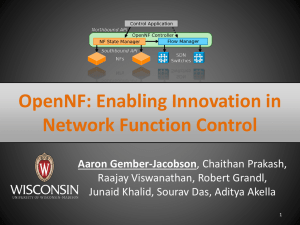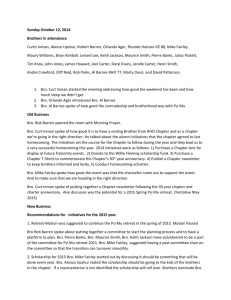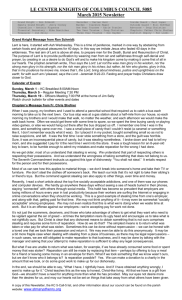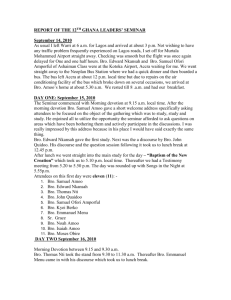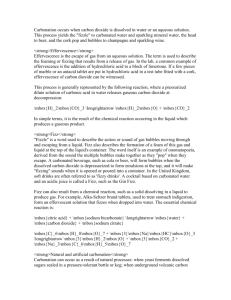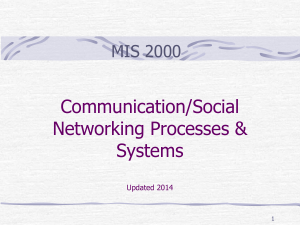05_29_14 - Stanford University Networking Seminar
advertisement
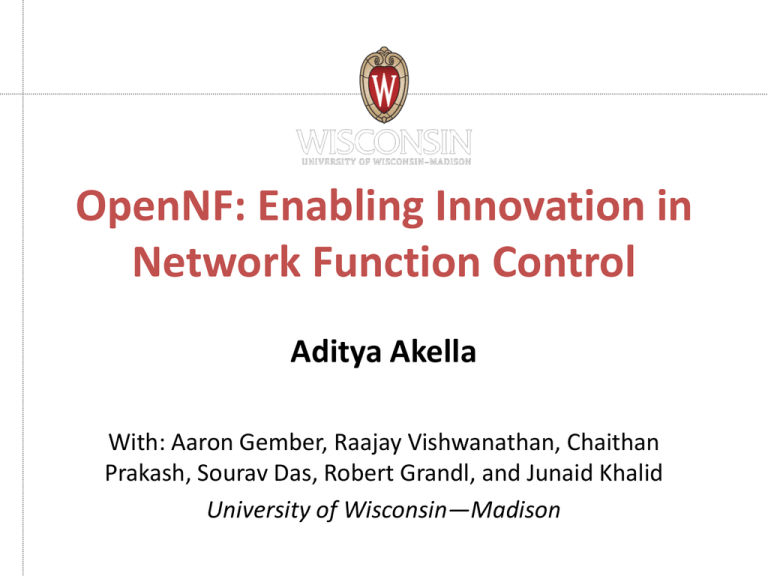
OpenNF: Enabling Innovation in
Network Function Control
Aditya Akella
With: Aaron Gember, Raajay Vishwanathan, Chaithan
Prakash, Sourav Das, Robert Grandl, and Junaid Khalid
University of Wisconsin—Madison
Network functions, or middleboxes
Introduce custom packet processing functions into the network
Firewall
Caching
Proxy
Intrusion
Traffic
Prevention scrubber
…
Load
balancer
SSL
Gateway
WAN
optimizer
Stateful: detailed
book-keeping for
network flows
[Sherry et al., SIGCOMM 2012]
Common in
enterprise,
cellular, ISP
networks
State-of-the-art
Network functions
virtualization (NFV)
– Lower cost
Xen/KVM
– Easy prov., upgrades
Software-defined
networking (SDN)
– Decouple from physical
– Better performance, chaining
3
NFV + SDN: distributed processing
Dynamic reallocation to coordinate processing across instances
Load balancing
SDN
Controller
MBox
MBox
Extract maximal performance
at a given $$
NFV + SDN: distributed processing
Dynamic reallocation to coordinate processing across instances
Load balancing
SDN
Controller
MBox
MBox
Key abstractions
SDN
1. Elastic Controller
2. Always
updated
3. Dynamic
enhancement
MBox Hand-off
MBoxfor
processing
a traffic subset
MBox
MBox
Extract maximal performance
at a given $$
MBox
What’s missing?
The ability to simultaneously…
Meet SLAs
– E.g., ensure deployment throughput > 1Gpbs
Ensure accuracy/efficacy
– E.g., IDS raises alerts for all HTTP flows
containing known malware packages
Keep costs low, efficiency high
– E.g., shut down idle resources when not needed
… needs more control than NFV + SDN
Example
Scaling in/out
sustain thr’put at low $
Home
Users
Firewall
Caching
Proxy
Intrusion
Prevention
Web Server
Not moving flows bottleneck persists
SLAs!
Naively move flows no associated state
Accuracy!
Scale down: wait for flow drain out
Efficiency!
Transfer live state while updating n/w forwarding
7
OpenNF
Quick and safe dynamic reallocation of processing
across NF instances
Quick: Any reallocation decision invoked any time
finishes predictably soon
Safe: Key semantics for live state transfers
No state updates missed, order preserved, etc.
Rich distributed processing based applications to
flexibly meet cost, performance, security objectives
Outline
Overview and challenges
Design
– Requirements
– Key ideas
– Applications
Evaluation
Dynamic
enhancement
Hot standby
Elastic scaling
Overview and challenges
Reallocation
operations
OpenNF Controller
Coordination
w/ network
SDN Controller
MBox
OpenNF
NF APIs and control plane for
joint control over internal NF
state and network
forwarding state
State import/
export
MBox
Overview and challenges
Challenges
1: Many NFs, minimal changes
– Avoid forcing NFs to use special state structures/
allocation/access strategies
Simple NF-facing API; relegates actions to NFs
2: Reigning in race conditions
– Packets may arrive while state is being moved; Updates
lost or re-ordered; state inconsistency
Lock-step NF state/forwarding update
3: Bounding overhead
– State transfers impose CPU, memory, n/w overhead
Applications control granularity, guarantees
11
NF state taxonomy
C1: Minimal NF Changes
State created or updated by an NF applies to
either a single flow or a collection of flows
Per-flow state
TcpAnalyzer
Multi-flow state
Connection
HttpAnalyzer
ConnCount
Connection
TcpAnalyzer
All-flows state
Statistics
HttpAnalyzer
Classify state based on scope
Flow provides a natural way for reasoning
about which state to move, copy, or share
12
C1: Minimal NF Changes
API to export/import state
Three simple functions: get, put, delete(f)
– Version for each scope (per-, multi-, all-flows)
– Filter f defined over packet header fields
NFs responsible for
– Identifying and providing all state matching a filter
– Combining provided state with existing state
No need to expose internal state organization
No changes to conform to a specific allocation strategy
13
Operations
“Reallocate port 80 to NF2”
move flow-specific NF state at
various granularities
copy and combine, or share,
NF state pertaining to multiple
flows
Semantics for move (loss-free,
order-preserving), copy/share
(various notions of consistency)
14
Move
Control Application
SDN Controller
move (port=80,Inst1,Inst2,LF&OP)
forward(port=80,Inst2)
OpenNF Controller
getPerflow(port=80)
delPerflow(port=80)
[ID1,Chunk1]
[ID2,Chunk2]
Inst1
putPerflow(ID1,Chunk1)
putPerflow(ID2,Chunk2)
Inst2
15
C2: Race conditions
Load-balanced network monitoring
Moving live state: some updates (packets) may be lost, or
arrive out of order
HTTP req
HTTP req
vulnerable.bro
weird.bro
move
vulnerable.bro reconstruct MD5’s for HTTP responses
– Not robust to losses
weird.bro SYN and data packets seen in unexpected
order
– Not robust to reordering
C2: Race conditions
Lost updates during move
• Packets may arrive during a move operation
Loss-free: All state updates
B2 due to packet processing
move(blue,Inst
1 ,Inst2 ) in the transferred
Inst2 is missing
updates
should
be reflected
state, and
all
packets the switch receives should be processed
B2
B1
R1
Inst1
Inst2
• Fix:
traffic
flow and
buffer packets
Keysuspend
idea: Event
abstraction
to prevent,
observe
– May last and
100ssequence
of ms state updates
– Packets in-transit when buffering starts are dropped
17
C2: Race conditions
Loss-free move using events
Stop processing; buffer at controller
1. enableEvents(blue,drop) on Inst1;
2. get/delete on Inst1
3. Buffer events at controller
B2
B3
B1
4. put on Inst2
5. Flush packets in B1
B2
drop
R1
events to Inst2
Inst1
6. Update
Controller
forwarding
B1,B2
B1,B2,B3
Inst2
18
Re-ordering of updates
Switch
Controller
Inst1
C2: Race conditions
Inst2
5. Flush buffer
6. Issue fwd
update
B2
B3
B3
B2
B2
B4
B3
B4
B3
B3
Order-preserving: All packets should be
processed in the order they were forwarded
to the NF instances by the switch
Two-stage update to track last packet at NF1
19
Order-preserving move
C2: Race conditions
Track last packet; sequence updates
Flush packets in events to Inst2 w/ “do not buffer”
enableEvents(blue,buffer) on
Inst2
Forwarding update: send to Inst1 & controller
Wait for packet from
switch (remember last)
Forwarding update:
send to Inst2
B4
B3
buf
B3
drop
R1
B1,B2,
B1,B2,B3
B1,B2
B1
B3, B4
Wait for event from
Inst2 for last Inst1 packet
Release buffer of packets on Inst2
B2
20
Bounding overhead
Apps decide, based on NF type, objective:
granularity of reallocation operations
move, copy or share
filter, scope
guarantees desired
move: no-guarantee, loss-free,
loss-free + order-preserving
copy: no or eventual consistency
share: strong or strict consistency
C3: Applications
C3: Applications
Load-balanced network monitoring
HTTP req
HTTP req
scan.bro
vulnerable.bro
weird.bro
scan.bro
movePrefix(prefix,oldInst,newInst):
vuln.bro
copy(oldInst,newInst,{nw_src:prefix},multi)
move(oldInst,newInst,{nw_src:prefix},per,LF+OP)
while (true):
weird.bro
sleep(60)
copy(oldInst,newInst,{nw_src:prefix},multi)
copy(newInst,oldInst,{nw_src:prefix},multi)
scan.bro
Implementation
Impl & Eval
OpenNF Controller (≈4.7K lines of Java)
– Written atop Floodlight
Shared NF library (≈2.6K lines of C)
Modified NFs (4-10% increase in code)
–
–
–
–
Bro (intrusion detection)
PRADS (service/asset detection)
iptables (firewall and NAT)
Squid (caching proxy)
Testbed: HP ProCurve connected to 4 servers
23
Microbenchmarks: NFs
Serialization/deserialization
costs dominate
Impl & Eval
Cost grows with
state complexity
24
Impl & Eval
Microbenchmarks: operations
• State: 500 flows in PRADS; Traffic:D 5000
pkts/sec
= f(load,state,speed)
• Move per-flow state for all flows
881 packets
250
400
300
Packets
dropped!
686 462
Per-packet Latency
Increase (ms)
Move Time (ms)
500
200
100
0
NG
NG PL
LF PL
LF
OP
PL+ER PL+ER
in events
200
150
100
50
0
Average Maximum
838 packets + 1120 packets
in events buffered at Inst2
Copy (MF state) – 111ms
Share (strong) – 13ms per pkt Guarantees come at a cost!
25
Macrobenchmarks:
end-to-end benefits
Impl & Eval
Load balanced monitoring with Bro IDS
– Load: replay cloud trace at 10K pkts/sec
– At 180 sec: move HTTP flows (489) to new Bro
– At 360 sec: move HTTP flows back to old Bro
OpenNF scaleup: 260ms to move (optimized, loss-free)
– Log entries equivalent to using a single instance
VM replication: 3889 incorrect log entries
– Cannot support scale-down
Forwarding control only: scale down delayed by more
than 1500 seconds
Wrap up!
• OpenNF enables rich control of the packet
processing happening across instances of an NF
• Quick, key safety guarantees,
• Low overhead, minimal NF modifications
http://opennf.cs.wisc.edu
27
Backup
Copy and share
C2: Race conditions
Used when multiple instances need to access a
particular piece of state
Copy – eventual consistency
– Issue once, periodically, based on events, etc.
Share – strong
– All packets reaching NF instances trigger an event
– Packets in events are released one at a time
– State is copied between packets
29
Example app: Selectively C3: Applications
invoking advanced remote processing
HTTP req
scan.bro
vulnerable.bro
weird.bro
HTTP req
scan.bro
vulnerable.bro
weird.bro
detect-MHR.bro
!
enhanceProcessing(flowid,locInst):
move(locInst,cloudInst,flowid,per,LF)
Enterprise n/w
Internet
No need for:
(1) order-preservation
(2) copying multi-flow
state
checks md5sum
of HTTP reply
Existing approaches
• Control over routing (PLayer, SIMPLE, Stratos)
• Virtual machine replication
– Unneeded state => incorrect actions
– Cannot combine => limited rebalancing
• Split/Merge and Pico/Replication
– Address specific problems => limited suitability
– Require NFs to create/access state in specific
ways => significant NF changes
31
Controller performance
Improve scalability with P2P state transfers
32
Macrobenchmarks:
Benefits of Granular Control
Impl & Eval
Two clients make HTTP requests
– 40 unique URLs
Initially, both go to Squid1
20s later reassign client 1 to Squid2
Metric
Ignore
Copy-client
Copy-all
Hits @ S1
117
117
117
Hits @ S2
crashed
39
50
State
transferred
0
4MB
54MB
Granularities
of copy
